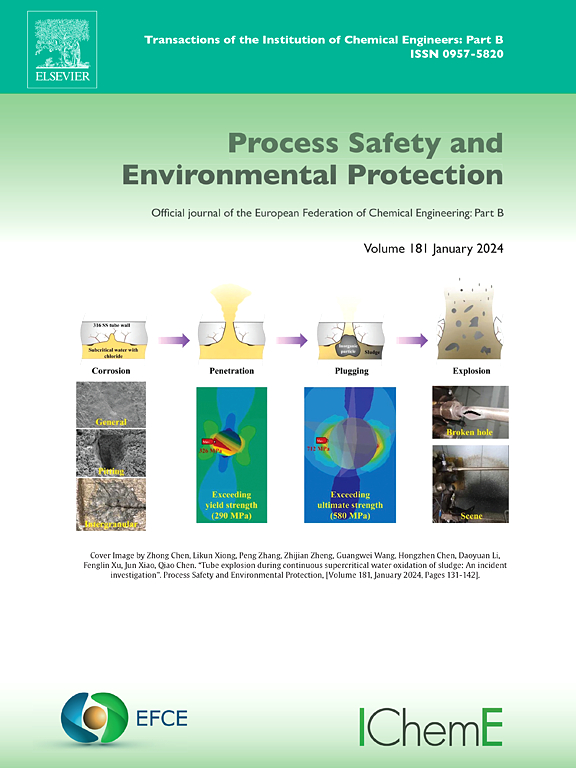Dissolution characteristics of steel slag in aqueous solution and preparation of high purity CaCO3
IF 6.9
2区 环境科学与生态学
Q1 ENGINEERING, CHEMICAL
引用次数: 0
Abstract
Steel slag (SS), a solid byproduct of the steel-making process, possesses high potential for value-added applications on account of its abundant content of CaO and MgO. These alkaline components make steel slag a viable candidate for carbonation and CO2 fixation processes. This study investigated the hydration of steel slag, focusing on how variables such as particle size, reaction temperature, and reaction time influence the characteristics and efficiency of the resulting products. The findings revealed that hydration predominantly occurs through the dissolution of free calcium oxide (f-CaO), with an optimal total dissolution rate reaching 7.2 %. Notably, the dissolution rates of Ca, Si, and Mg were 10.7 %, 2.0 %, and 0.6 %, respectively, and the dissolution rate of Fe was almost zero. The surface covering model effectively described the interaction of steel slag in an aqueous solution. Under conditions of temperature at 25 ℃, a CO2 flow rate of 200 mL/min, stirring speed at 600 rpm, and an aging time of 0 min, a pure calcium carbonate product with a purity level of 99.5 % and a particle size measuring 4.98 μm was successfully obtained. This study would offer a potential application approach for exploiting low-cost industrial solid waste steel slag to prepare calcite-type calcium carbonate, realizing the high-value utilization of steel slag and CO2 fixation as well as emission reduction.
钢渣在水溶液中的溶解特性及高纯碳酸钙的制备
钢渣是炼钢过程中产生的固体副产物,由于其含有丰富的CaO和MgO,具有很高的增值应用潜力。这些碱性成分使钢渣成为碳化和二氧化碳固定工艺的可行候选物。本研究对钢渣的水化进行了研究,重点研究了粒度、反应温度、反应时间等因素对产物特性和效率的影响。结果表明,水化主要通过游离氧化钙(f-CaO)的溶解发生,最佳总溶解率为7.2% %。值得注意的是,Ca、Si和Mg的溶出率分别为10.7 %、2.0 %和0.6 %,Fe的溶出率几乎为零。表面覆盖模型有效地描述了钢渣在水溶液中的相互作用。在温度为25 ℃,CO2流量为200 mL/min,搅拌速度为600 rpm,老化时间为0 min的条件下,可制得纯度为99.5 %,粒度为4.98 μm的纯碳酸钙产品。本研究为开发低成本的工业废钢渣制备方解石型碳酸钙,实现钢渣的高价值利用和二氧化碳固定减排提供了一条潜在的应用途径。
本文章由计算机程序翻译,如有差异,请以英文原文为准。
求助全文
约1分钟内获得全文
求助全文
来源期刊

Process Safety and Environmental Protection
环境科学-工程:化工
CiteScore
11.40
自引率
15.40%
发文量
929
审稿时长
8.0 months
期刊介绍:
The Process Safety and Environmental Protection (PSEP) journal is a leading international publication that focuses on the publication of high-quality, original research papers in the field of engineering, specifically those related to the safety of industrial processes and environmental protection. The journal encourages submissions that present new developments in safety and environmental aspects, particularly those that show how research findings can be applied in process engineering design and practice.
PSEP is particularly interested in research that brings fresh perspectives to established engineering principles, identifies unsolved problems, or suggests directions for future research. The journal also values contributions that push the boundaries of traditional engineering and welcomes multidisciplinary papers.
PSEP's articles are abstracted and indexed by a range of databases and services, which helps to ensure that the journal's research is accessible and recognized in the academic and professional communities. These databases include ANTE, Chemical Abstracts, Chemical Hazards in Industry, Current Contents, Elsevier Engineering Information database, Pascal Francis, Web of Science, Scopus, Engineering Information Database EnCompass LIT (Elsevier), and INSPEC. This wide coverage facilitates the dissemination of the journal's content to a global audience interested in process safety and environmental engineering.
 求助内容:
求助内容: 应助结果提醒方式:
应助结果提醒方式:


